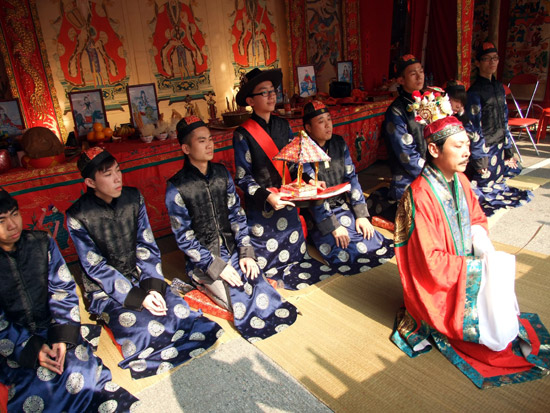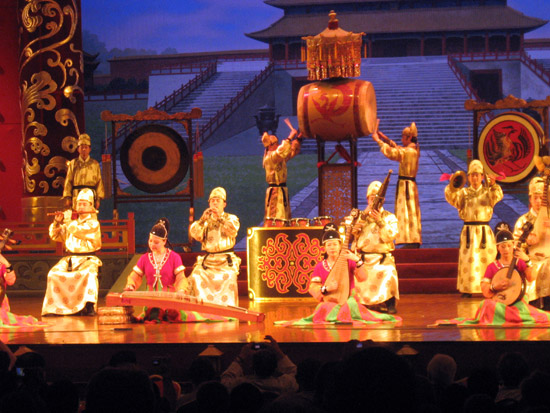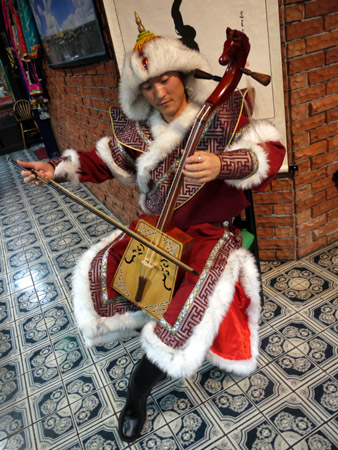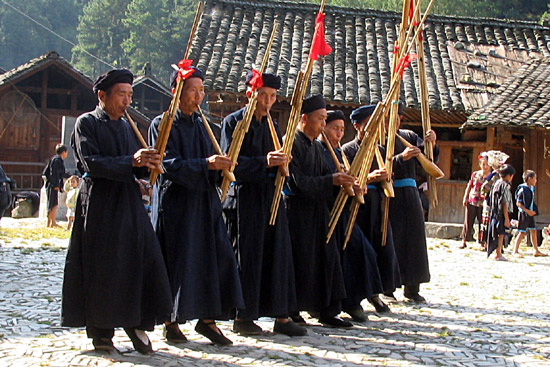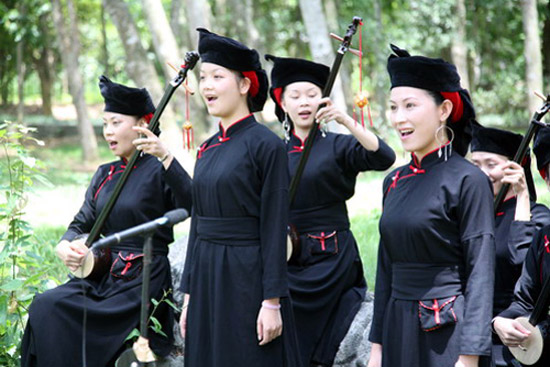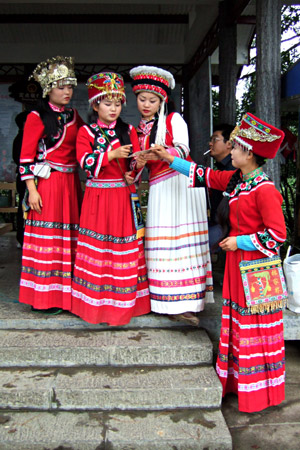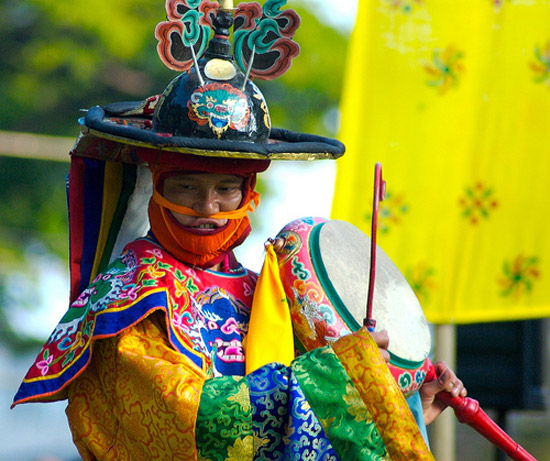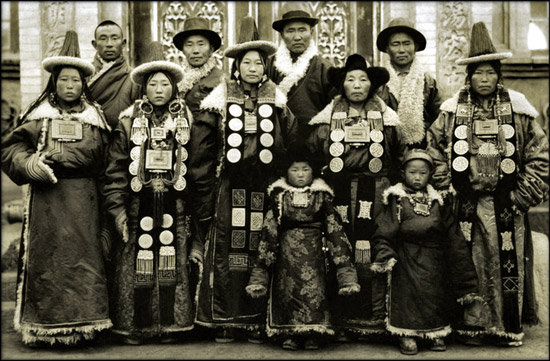Music: Traditional Forms
Chinese Opera
Musical theater evolved in the Wei-Jin periods and grew more sophisticated under the Tangs. The operas used Classical Chinese, but, under the Yuans, vernacular zaju variety shows became popular. The kunqu opera from the Wu region, which gained prominence under the Ming and early Qing dynasties, developed into the longer chuanqi, and this later became a part of the Sichuan opera from Sichuan province. The Peking opera developed in the latter Qing period. Operatic themes in both forms covered domestic scenes, romances, heroic tales, folklore, and historic events, combining narratives with songs, dances, mimes, and acrobatics, with the performers often wearing elaborate, colorful costumes and masks.
In the 20th century, the operas adapted Western dramatic techniques and musical instruments. The communist takeover and the Cultural Revolution did not bode well for the Chinese operatic tradition; anything that Mao’s wife Jiang Qing disliked was abolished. The banned operas were revived later, but political whims still decide the operatic content.
Temple Music
Buddhist and Taoist music developed from Sanskrit religious music, and continues to be performed by monks and nuns during temple rituals and festivals. The vocals include solo and choral chanting and recitation from the scriptures, performed in high-pitched, flourishing rhythms to the accompaniment of wind and percussion instruments. The Taoist temples on the Qianshan, Longshu, Maoshan, and Wudang Mountains, and the Buddhist temples on Wutai Shan (Mount Wutai) and in Beijing, are some places to hear temple music.
Overtone throat singing, similar to the Mongolian khoomei style, is employed to chant Sanskrit and Tibetan sutras (short literary compositions) in Tibetan Buddhist rituals. The singers—exclusively men—produce two notes, drone and harmonics, simultaneously; the idea is to re-create various nature sounds—a running horse, a swift river, a waterfall, chirping birds, and so on—and the whole effect, with many voices chanting in unison, to the accompaniment of drums and horns, can be very mystical and powerful. Gelugpa monks practice dzoke and ranke throat singing, and Jezun Sherab Senge, the founder of the Gyudmed Monastery, created the low-pitched, very difficult gyuke style. The gravelly yang chanting is performed without rhythmic timing. Gyer is closely related to the ancient Bön chants.
Folk Music
Founded by Thangton Gyalpo in the 14th century, the lhamo folk opera is performed during Linka (New Year Festival), Shoton (Yogurt Festival), and other celebrations. The performance takes place, without props, under a decorative canopy, and the brightly costumed performers include a shung shangken (a male narrator), an ache lhamo (sister goddess) chorus, ngon-pas (hunters), and gyallu (monks). The play—based on incidents from Tibetan history, the lives of great Tibetan teachers like Guru Padmasambhava and Tsongkhappa, and Jataka Tales, embellished with commentaries on current events—begins with a ritual dance and homages to Thangton Gyalpo, to the Dalai Lama, and to the gods. The plot is narrated in classical Tibetan, with the characters entering and exiting the stage dancing. The main characters sing their parts, the comic characters speak in prose, and all the characters chorus the last lines of the solo namthar songs. The nga and the bubchal provide musical accompaniment.
Tibetan folk songs include work songs for various farming and building activities; wedding songs; social drinking songs; pilgrimage songs; children’s songs; poetic songs extolling the natural beauty of Tibet; narrative songs on Buddhist parables (the Lama Mani tradition); the lu songs that are sung with high-pitched, glottal vibrations and no musical accompaniment; and the satirical street songs that evolved to keep people informed about social and political situations. Generally, the short, simple folk lyrics can be adapted to different tunes, allowing for different interpretations of the same song.
The Epic of Gesar—which recounts the life and times of Gesar, the historical/mythical ruler of Ling, and Tibet’s national hero—probably developed during the formation of the Kadampa, Kagyu, Nyingmapa, and Sakya schools. The babdrung bards performed the songs in straight narrations or trance-induced chants, and passed them on by oral tradition. There was no written text before the Qing Emperor Kangxi commissioned a Mongolian woodblock print in Beijing in 1716, after which time reading from the text also became an acceptable way of presenting the epic. There is no definitive version though, as over the centuries many local and regional variations evolved, and performers regularly improvise the story. Current events are liberally incorporated—during the performances of World War II, for instance, Gesar, not content with vanquishing the demons in the home country, traveled all the way to Germany to take on Hitler.
Regional and Ethnic Forms
Han
The Hans form a substantial ethnic majority in China (around 90 percent of the population), and they follow Buddhist, Taoist, and Confucian beliefs. Han music is mainly instrumental, based on the pentatonic scale and featuring the qin, pipa, xiao, zheng, di, and erhu. There are also shange (mountain songs) and long narrative songs, often made up of smaller songs, which may be performed over a period of several days; these songs were banned by the communists and almost disappeared during the Cultural Revolution.
The vocal music is melodic, and covers a wide range of themes, including the historical, the romantic, and the mundane, as well as folktales and folklore. There are regional differences in the types of songs, singing styles, and instrumental accompaniment. Han folk music is performed at festivals, weddings, funerals, and other occasions by chuigushou ensembles that comprise the oboe-like suona and various percussion instruments.
Han temple fairs known as hua’er, after the high-pitched hua’er songs (flower songs), are traditionally performed outdoors, with both genders participating in the singing; the songs are actually a courtship ritual, and often have seductive lyrics. Hua’er songs are also performed in the temples, albeit with a more reverent slant, praying for well being, children, rain, and other auspicious events.
Mongol
Influenced by their nomadic culture, shamanistic beliefs, and Tibetan Buddhism, traditional Mongol music includes khoomei throat singing, in which the singer creates an extended range of sounds that incorporate overtones and guttaral tone, and the urtyn duu, or long song—long in this case referring to the extension of the syllables, not the lyrics. In both vocal forms, the singers accompany themselves with the versatile horse-headed fiddle, morin khuur. Other cultural highlights include the Buddhist cham dances, and the songs and stamping dances in the mahan opera.
Uyghur
The muqam tradition of the Islamic Uyghurs of Xinjiang and Hunan is meant, more than just entertainment, to serve a religious and meditative purpose. The four main regional types are the Kashgar-Yarkand, Turpan, Qumul, and Dolan muquams. Structurally, each muqam consists of a neghma—which has an introductory muqaddine, several dastans (pieces), and the instrumental marghul—and the fast-paced, poetic meshrep. Different muqams will have different vocals and instrumental pieces. Muqam lyrics are adapted from the poetry of Zelil, Fuzuli, and other great poets, from folktales and folklore, and from Sufi philosophy.
The Uyghurs also have epic and historic songs, narrative songs like qoshaq and maddhi, senem dance music, the melancholy zatch folk songs, and Sufi zikr (remembrance) rituals and hokmet songs; these last are performed by ashiq and gelender (male singers), while buwi (women singers) perform the munajat ritual songs at shrines, at funerals and during exorcisms. Bakshi singers (wandering shamans) perform folk songs and trance-inducing dances as part of their religious rituals.
Miao and Yao
In the absence of a written language, the Miao (Hmong) people of Guizhou, the second-largest minority in China, have orally transmitted their music down the generations. Sung at festivals, weddings, births, funerals, social visits, and various work activities, Miao songs deal with their creation myths, history, animistic beliefs, and everyday activities. There are playful courting songs as well as songs reflecting the historical sufferings of the Miao people. Miao instrumental music incorporates the tonal language as words, making it possible to tell a narrative story (or sing a poem) solely by playing the instrument.
The related Yao nationality includes various Chinese minorities from the mountainous regions of southwestern and Southern China; they have plowing, sowing, and harvesting songs that are performed in groups with a drummer setting the pace.
Zhuang
Residing in the Guangxi, Guizhou, Guangdong, Hunan, and Yunnan provinces, the Zhuangs are known for their Baeu Rodo epic and geyu ballad singing events that take place during the spring and autumn festivals. The geyu events often last for one to three days, and people of all age groups participate. The antiphonal songs deal mainly with romance. There are dances miming activities such as husking rice, plucking tea leaves, catching shrimp, and other mundane tasks, and also various operas and puppet shows.
Manchu
The Manchus form the third largest ethnic group in China. Their traditional music is influenced by shamanism, folk traditions, and also by the Hans and the other subcultures. The instrumental music uses percussion, particularly the dangu drums, conveying a variety of symbolic and ritualistic meanings with different drum patterns. Apart from religious rituals, the music is played during the Manchu folk dances and operas.
Dong
The mountainous Dong villages in northern Guangxi, western Hunan, southeastern Guizhou, and Hubei are centered around a pagoda-like drum tower. Music is a part of the animist Dong rituals as well as a social activity, performed for everyday housework, farming, births, weddings, funerals, and, of course, for entertainment. There are solo and choral songs, with romantic, cultural, social, historical, moral, and religious themes. Musical instruments like pipa and Dong lutes are used.
Yi
The Yi live primarily in rural areas of Sichuan, Yunnan, Guizhou, and Guangxi, and are the seventh largest minority group. They follow animist, shamanistic, and Taoist beliefs, and their songs and dances are performed on festivals like the Yi torch festival, on holidays and for social events. The song themes include their mythology, folktales, and epics.
Tujia
The remote, mountainous regions of Sizhu have kept the Tujia culture comparatively free of outside influences. The Tujia are known for their exclamatory luo’er songs and their vigorous, hand-swinging dances, performed to the accompaniment of the suona and drums during ancestor-worship rituals. The dances can last several days, with the dancers enacting work, romance, household life, and war. The dancers cover their faces in straw and praise their ancestors in the maogusi dance, while the tiaosong dance is performed at funerals, and the sayeryo dance celebrates birth and life. Traditionally, only men dance; women save themselves for the crying marriage songs, in which, for ten days before the wedding, the bride and her friends weep and bewail the coming fate. The nuo opera combines acting, singing, and dancing, with the drum and gong instrumental music.
Tibet
Elaborately masked and costumed dancers perform the lively cham dances to the accompaniment of chants, cymbals, horns, and dramnyen during Tibet's Monlam Prayer Festival and other religious events. Different festivities have different cham dances, which were also once part of the monastery initiation rituals. Cham dances depict events from the lives of Guru Padmasambhava and other Tibetan teachers, and from the historical Council of Lhasa debates between the Chan monk Mo Ho Yen and the Indian monk Kamalasila. The performances are usually held in temple or monastery courtyards. Male dancers perform gar dances at the Dalai Lama’s court and at state events.
The closely related, melodic nangma and töshe evolved in Ngari, western Tibet, from the songs King Trisong Detsen and his courtiers sang at the founding of the Samye Monastery in the 8th century CE. In the 17th century, after a nangma performance at the Ngari Choegyal’s palace charmed Desi Sangyal Gyatso, the regent of the fifth Dalai Lama, the genre became popular at the Lhasa court. Musicians formed the nangma kyidug (association), Dhoring Tenzin Paljor composed songs like “Gya ja lak” and “Kalpa Sangsong,” and the Zonggyab Lukhang ritual prayers for Goddess Lu used nangma music. Dramnyen, piwang, lingbu, gyumang, lingshang, and erkha provide musical backing, and a fast-paced dance is performed at the end. In the 20th century, Acho Namgyal and his nangma ensemble revitalized the waning popularity of nangma and töshe, but the arrival of the gramophone eclipsed the interest in live musical performances, and the nangma kyidug disbanded in 1942.
The traditional songs of Tibet's Amdo, U-Tsang, and Kham regions are sung in the regional vernacular and show unique regional variations. Amdo's songs reflect its nomadic grassland terrain and culture, Kham's songs reflect its horse festivals and warrior tradition, and U-Tsang, with Lhasa as its focal point, is considered the traditional origin and center of Tibetan civilization. There are certain similarities among the song forms of each, such the use of free meter, fluctuating rhythms, and lack of musical accompaniment in the pastoral lhalu (U-Tsang), le (Amdo), and lu (Kham) songs. Amdo Region (politically entirely within China’s Qinghai Province, rather than in the Tibetan Autonomous Region like U-Tsang and part of Kham) has an operatic tradition based on folk songs and dances; Chinese operas have also influenced its costumes and set designs.
Article written for World Trade Press by Sonal Panse.
Copyright © 1993—2025 World Trade Press. All rights reserved.

 China
China 